Metal-Dielectric mirrors utilizing three gradient refractive index dielectric materials for 10.6 μm wavelength applications
IF 3.1
3区 物理与天体物理
Q2 INSTRUMENTS & INSTRUMENTATION
引用次数: 0
Abstract
Thin films are crucial in optics, particularly in fabricating high-reflectivity mirrors for high-power lasers. We propose a novel approach that transcends traditional low–high refractive index (LH) structures by designing a metal-dielectric mirror composed of three materials with gradient refractive indices. The optimal process was selected by thoroughly investigating the properties of ZnSe and YbF3 thin films under varying ion-assisted energies. Using Macleod software, we meticulously designed the optical thicknesses of the ZnSe and YbF3 coatings, striking a delicate balance between reflection and absorption within the mirror’s dielectric layer, thereby minimizing the overall reflection loss. The resulting mirrors exhibited a remarkable reflectivity of 99.92 % at a wavelength of 10.6 μm, coupled with a significantly low stress level of −18.66 MPa. These results boost the efficiency and durability of laser systems, underscoring the potential of mirrors for various industrial applications.
求助全文
约1分钟内获得全文
求助全文
来源期刊
CiteScore
5.70
自引率
12.10%
发文量
400
审稿时长
67 days
期刊介绍:
The Journal covers the entire field of infrared physics and technology: theory, experiment, application, devices and instrumentation. Infrared'' is defined as covering the near, mid and far infrared (terahertz) regions from 0.75um (750nm) to 1mm (300GHz.) Submissions in the 300GHz to 100GHz region may be accepted at the editors discretion if their content is relevant to shorter wavelengths. Submissions must be primarily concerned with and directly relevant to this spectral region.
Its core topics can be summarized as the generation, propagation and detection, of infrared radiation; the associated optics, materials and devices; and its use in all fields of science, industry, engineering and medicine.
Infrared techniques occur in many different fields, notably spectroscopy and interferometry; material characterization and processing; atmospheric physics, astronomy and space research. Scientific aspects include lasers, quantum optics, quantum electronics, image processing and semiconductor physics. Some important applications are medical diagnostics and treatment, industrial inspection and environmental monitoring.

 求助内容:
求助内容: 应助结果提醒方式:
应助结果提醒方式:


